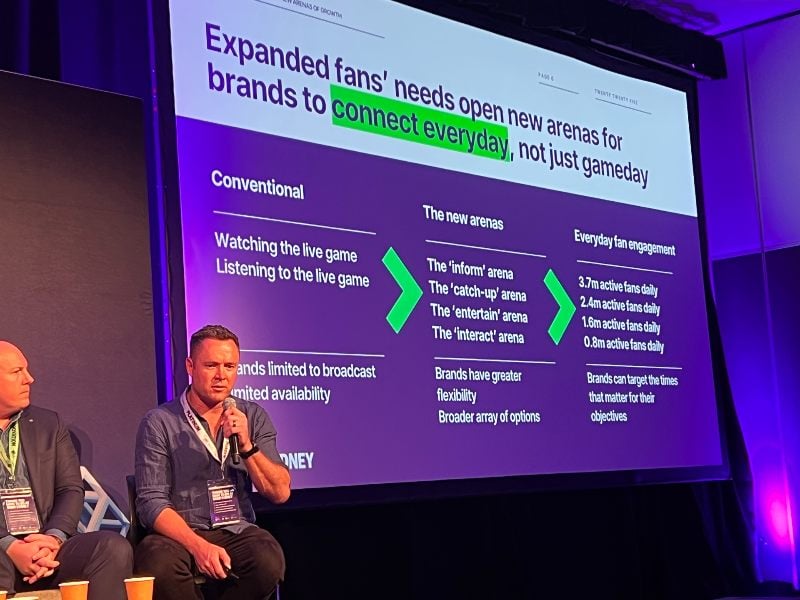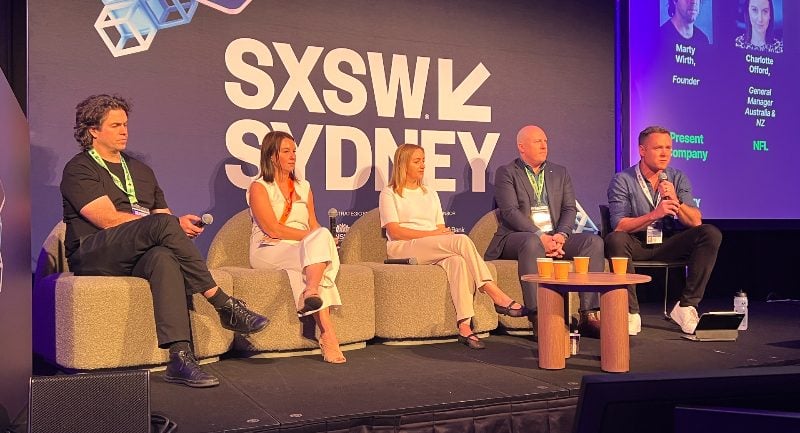Gone are the days of sports being defined by your dad on the couch watching the footy on the weekend.
Sure, that still happens in a lot of households, but sports today is more multi-platform with a far more diverse and inclusive audience. It is now commonplace to watch your favourite sport via clips on social platforms as it is to dedicate your entire weekend to watching full games.
Taking to the stage at SXSW was The Growth Distillery’s Head of Commercial Leigh Lavery. He moderated a panel that brought together a who’s who of sports execs who define what sports and sport fandom looks like in 2025 and beyond.
Joining the panel for Unlocking Growth in the all-week sport ecosystem was UFC Senior VP, Australia & NZ , Peter Kloczko, Bulldog CEO, Kim Anderson, NFL GM Australia & NZ ,Charlotte Offord, and Present Company Founder Marty Wirth.
In days, The Growth Distillery will release Sporting Nation 2025 – an annual report into the way we consume and engage with sports.
The panel at SXSW was an extension of the research that Lavery and his team have been doing around the economics of sports fandom.
During the panel, conversation focused on three types of sports consumer that Lavery and his team have identified:
The Fanatics – These are the heaviest consumers. They are Tier 1 sport obsessed, see sports as core to their identity, and consume 8 hours a week (or more) – 51 per cent of their consumption goes beyond live.
New Wave Fans – Seen as ‘digital curators,’ only 1 in 2 watch live per week with sports interest balanced across local and global sports. They’re digitally-led and consume around 5 hours a week – 65 per cent beyond live.
The Followers – These are the lightest consumers who are occasion-led in that they are there for sports as a social occasion. They’re watching around 3 hours a week, with 45 per cent beyond live.
Following the panel conversation, Mediaweek talked to Lavery about modern sports fandom, how the panel aligned with the report being released next week, and some big picture questions about the future of sport consumption in Australia.
Mediaweek: Having worked on this years Sporting Nation 2025 report, was there any surprises in what the panel had to say that surprised you at all?
Leigh Lavery: No real surprises, probably more just how much they were embracing these concepts. To be honest with you, before we did this study there were more hypotheses, if that makes sense.
What we’ve seen over the last few editions has been this shift beyond the live. And it’s something that we can see in the numbers. It’s almost like a sports census, you can see it in the numbers.
But when you actually get to speak to the real industry participants and hear from them firsthand around their experience of it, it’s really reaffirming what we’re observing.
Mediaweek: The study itself is designed for marketers to understand how to navigate the sports landscape, and particularly for them to find a pathway for growth.
Leigh Lavery: At The Growth Distillery, that’s what we’re absolutely focused on. We want to make pathways clearer for marketers to be able to navigate the noise, particularly in sport, but a lot of fields. Things are getting more complicated, noisier, and it’s creating a sense of overwhelm, not just for consumers, but for marketers.
What we try to do is take a holistic view of the landscape and look for where there’s reasons to be optimistic, and areas where maybe marketers should feel that there is an opportunity for growth.
Mediaweek: How much of the report then feeds back into News Australia as they shape their editorial and marketing?
Leigh Lavery: We want to be able to help give the executive and the editors at News Corp the ability to make better informed decisions over the sports they cover, how they cover them, the fans that matter, and probably the opportunities again for growth for News Corp.
We have a version that we create specifically for the News Corp business, and then what we try to do and what The Growth Distillery is all about, is it distils the best parts, or the parts that we think are most relevant for the market.
That way our partners and the people, the marketers that we speak to, can also benefit from the work.
Mediaweek: Sports reporting is no longer just confined to the sports section of a publication. I assume reports like this help set editorial direction around that cultural shift?
Leigh Lavery: The expansion of sports has a lot to do with the blurring of boundaries. Where does sport stop and where does entertainment and culture start?
It’s interesting, at News Corp there’s a really powerful statement around how we want to cover sport. We think there’s a lot of opportunities for getting behind or around the sporting field and getting more into behind the scenes, around the personalities behind sport, and really understanding the lives of these players.
That was one of the discussion points today – just how important the personality of these stars actually are and understanding the whole person, not just the athlete.
So that’s certainly an area where we see there’s a lot of pretty exciting opportunities for the news business, but also for our partners and also for other brands involved in sport.
Mediaweek: How many years has this been going for?
Leigh Lavery: This is our fourth edition out of five years. 2021 was our first study. I’ve worked on all of them.
Mediaweek: Would I be wrong in saying that it gets more interesting every year?
Leigh Lavery: It certainly does. What’s interesting about it is you’re seeing trends continue to evolve and some accelerate, some decelerate. And what I find interesting is sometimes the things that you think that will accelerate don’t quite pan out that way.
Mediaweek: Sports is always at the forefront of every major news technology coming through.
In 2021, we wrote some core thematics that we thought were going to be pathways for growth. And one of them was sport as an entertainment proposition. I remember when I put that down on the page and I talked to some of our exec crew, they sort of looked at me strangely.
I was explaining that the rise of docu-series, the rise of podcasts, the rise of the story behind the story, what the athlete’s going through off the field. And even a lot of these players and the audiences they’re generating on social media, they’re telling their truer selves, right? All of these things were indicators that there was a big opportunity coming.
Now we’ve seen in subsequent years, that’s probably accelerated beyond what we would have imagined. And that’s now a really powerful opportunity for, I think, all walks of sport. It is getting to know the people behind the player.

Mediaweek: Where is the majority of the growth actually coming from?
Leigh Lavery: It’s really a combination of it all. The number of people in Australia that now consider themselves a sports fan has got bigger. Of the 3.7 million new fans, there’s over a million that are female.
There’s a significant chunk are also culturally and linguistically diverse. We can say there’s this deeper engagement too.
What we’re seeing is that the Australian sporting diet is expanding. We’re no longer a country that has meat and three veg. We’ve got more interesting and diverse sporting tastes than we would have had, say, five years ago. Definitely ten years ago.
That creates opportunities for not only media, but also for brands that want to grow as well.
Mediaweek: Are new platforms like Kayo, Disney+, Paramount+, Stan Sports, Prime Video, and Netflix just offering a pathway for digital migration of traditional fans, or do you think they’re actually helping to create growth? Are the new fans only coming by way of social channels?
Leigh Lavery: I’d say it’s a combination of both. The level of access that fans now have to content is unlike anything we could have imagined, say, 10, 15, 20 years ago.
That’s opened up opportunities for fans to engage with a whole variety of different sports in a whole variety of different content formats and probably a whole variety of different shades of coverage that we couldn’t have fathomed years ago.
What we’ve seen is that with those eyeballs, the money’s following it. We can see that the investment in how to grow via sport is you’ve got to follow where people are spending their time and where they’re engaged.
Mediaweek: If viewer engagement is changing and the bulk of fans are consuming via clips and other platforms these days, do you think that weakens the need for sports to be available on free-to-air TV?
Leigh Lavery: Oh, look, it’s a really hard question. It’s a real balancing act between sport being accessible for everyone, because of the benefits it has to society and future generations, but there’s also commercial realities.
In this day and age, with our media landscape, particularly in Australia, you sometimes wonder, do we need to add extra layers of complexity to what’s already a pretty hard competition for some of our local players?
Sport, I firmly believe, is good for society. So we need to protect access to it.
But we need to also make sure that we give our local media players as much opportunity as possible to be able to compete with the global players in the coverage of not only our local sports, but all the sports that matter.
Mediaweek: Is sport the one shared cultural experience we have left?
Leigh Lavery: I’d say that and probably Taylor Swift. [laughs]
As the world continues to be shaped pretty rapidly by new technologies, sport’s going to have even more importance to society.

